#edit: updated image id
Text

18/08/2023
Ну, Заяц! Ну, погоди!
#daily bunny#230#fan bunny#nu pogodi#ну погоди#loved it as a kid soo much#i wasn't trying too hard to capture the style tho fdsgfdh#only a lil bit#edit: updated image id
162 notes
·
View notes
Text
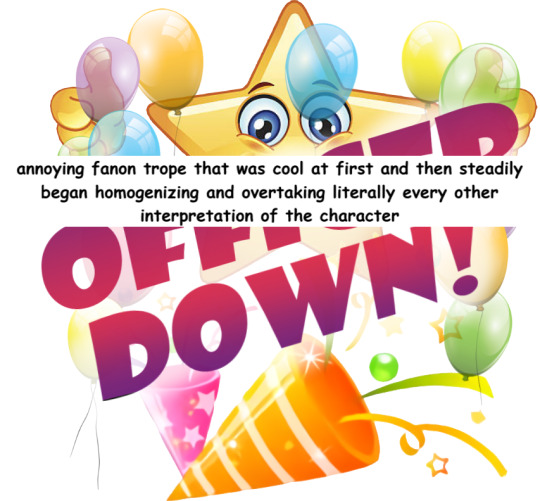
btw i am having a GREAT day today
#txt#pic#salt#im not maintagging this just know. you all know.#orig#can we get woobie jimmy in general next pls <3#update: EDITED WITH IMAGE ID IN ALT thanks crastlefolke :>
472 notes
·
View notes
Text

[Image ID: An drawn image of a manga-stylised feminine-presenting character with pink hair crying. They have one hand lifted to their eye to wipe their tears. /End ID]
#for when you want to convey that you're crying but also that you're doing it in a shoujo sorta way#reaction image#reaction meme#daily reaction images#image mood: ;_;#submission#EDIT: updated the image ID bc this character might not be a girl after all. Oopsie-dasies. Thanks to everyone in the tags flagging that up!#ID PERSON HERE: THAT WAS MY BAD SORRY EVERYONE
25 notes
·
View notes
Text

[Image Description: A white text box: "Accounts created after May 8th, 2023 have the 'For You' tab as the default dashboard tab. Other existing users' dashboard tabs are not changed. We are also working on making dashboard tabs even more customizable, including adding the ability to choose which tab appears first." End ID.]
From the latest update (June 2nd, 2023)
Oh, fuck this. If you're a new user, don't forget to set your dashboard to Following and turn "Based on your likes" and "Best stuff first" off
EDIT: A few corrections
For new users, you can't change the default back to Following. This means that whenever you open up your app/go to your dash, the first tab you'll see is the For You tab
Note for the previous point, I can't confirm this since my account is rather old, if anybody has an examples, I'd appreciate it
Yes, some people mentioned that you don't have to turn off Based on your likes and Best stuff first, but that's mostly my preference since (to me at least) it does not work, it just shows me random shit that is absolutely not based on my likes
My main problem with this update is that it strips the user from being able to choose what they wanted to see. It's totally cool if you use the For You tab, but it shouldn't be the default option
Additional points from the tags and reblogs:
You can turn off public likes and followings, again, not mandatory, but it's an option
Make sure to turn off Tumblr Live (pretty sure it's only available to US users, which I am not one) since it apparently drains mobile data
There are (browser) addons and extensions that allows you to block elements or make your tumblr experience better, like uBlock Origin (an adblocker which can be used to block certain elements from showing up) and the XKit Control Panel/New XKit
#pink posts#what the fuck is this update hello???#one week later edit: yeah a few corrections#also why the fuck did this explode
24K notes
·
View notes
Note
Trump was shot at again! NYTimes has updated articles concerning FBI investigation

[Image ID: The Destiel confession meme edited so that Dean answers 'Donald Trump assassination attempt 2: electric boogaloo was not on my 2024 bingo card.' to Cas' 'I love you'. /End ID]
#thanks for the info#donald trump#donald trump assassination attempt#destiel news channel#destiel meme#destiel#supernatural#spn#us politics
821 notes
·
View notes
Text


MAJOR UPDATE ON THE WGA STRIKE
edit: image ID in this reblog
3K notes
·
View notes
Text
Fuck AMPTP and the bullshit going on. I'm tired, might not do this well:
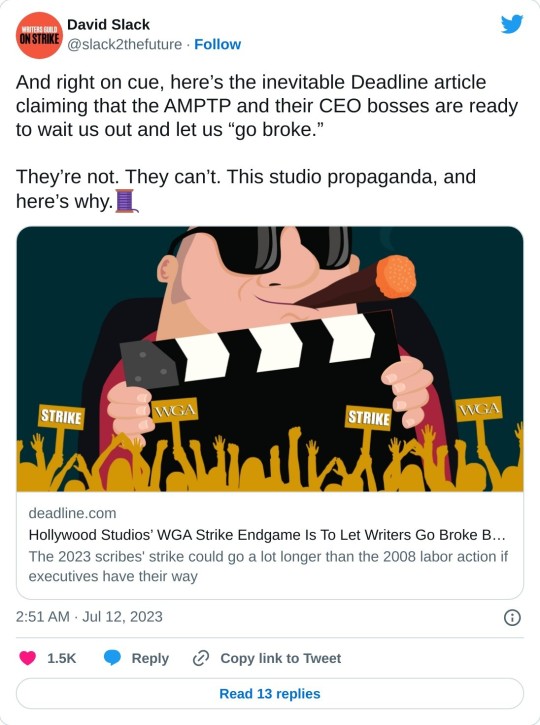
(link to article in above picture) From The Article
Receiving positive feedback from Wall Street since the WGA went on strike May 2, Warner Bros Discovery, Apple, Netflix, Amazon, Disney, Paramount and others have become determined to “break the WGA,” as one studio exec blatantly put it.
To do so, the studios and the AMPTP believe that by October most writers will be running out of money after five months on the picket lines and no work.
“The endgame is to allow things to drag on until union members start losing their apartments and losing their houses,” a studio executive told Deadline. Acknowledging the cold-as-ice approach, several other sources reiterated the statement. One insider called it “a cruel but necessary evil.”
The studios and streamers’ next think financially strapped writers would go to WGA leadership and demand they restart talks before what could be a very cold Christmas. In that context, the studios and streamers feel they would be in a position to dictate most of the terms of any possible deal.
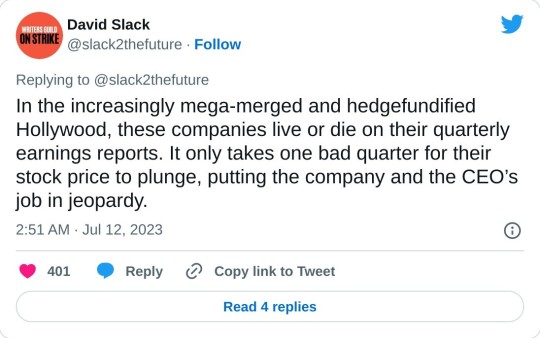
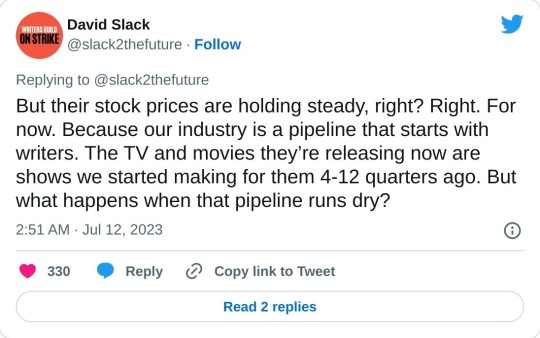
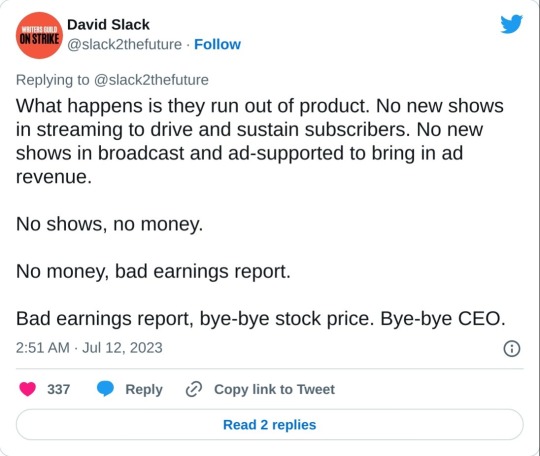

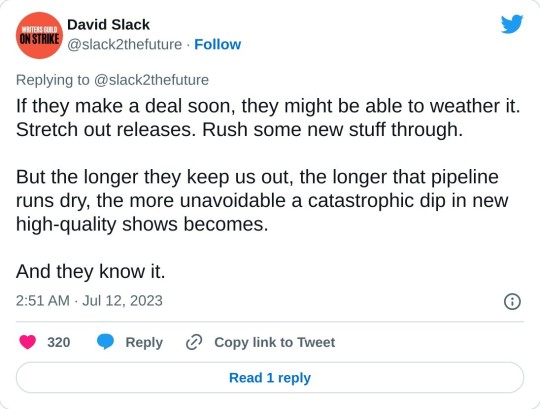
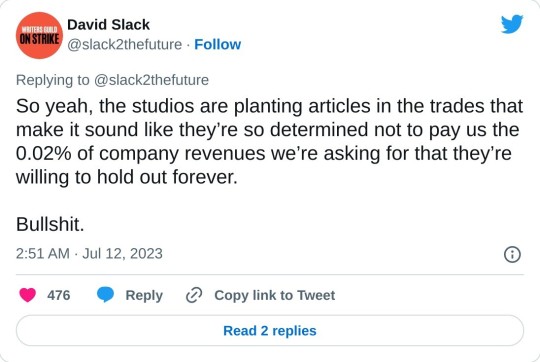

[Image IDs: Twitter thread by David Slack posted July 12th, 2023 that reads in totality:
And right on cue, here’s the inevitable Deadline article claiming that the AMPTP and their CEO bosses are ready to wait us out and let us “go broke.”
They’re not. They can’t. This studio propaganda, and here’s why.
In the increasingly mega-merged and hedgefundified Hollywood, these companies live or die on their quarterly earnings reports. It only takes one bad quarter for their stock price to plunge, putting the company and the CEO’s job in jeopardy.
But their stock prices are holding steady, right? Right. For now. Because our industry is a pipeline that starts with writers. The TV and movies they’re releasing now are shows we started making for them 4-12 quarters ago. But what happens when that pipeline runs dry?
What happens is they run out of product. No new shows in streaming to drive and sustain subscribers. No new shows in broadcast and ad-supported to bring in ad revenue.
No shows, no money.
No money, bad earnings report.
Bad earnings report, bye-bye stock price. Bye-bye CEO.
After 70+ days with no writers to create their product for them, the pipeline is running dry.
Their stock price isn’t tanking yet. But if they don’t make a deal with us, it will.
And they know it.
If they make a deal soon, they might be able to weather it. Stretch out releases. Rush some new stuff through.
But the longer they keep us out, the longer that pipeline runs dry, the more unavoidable a catastrophic dip in new high-quality shows becomes.
And they know it.
So yeah, the studios are planting articles in the trades that make it sound like they’re so determined not to pay us the 0.02% of company revenues we’re asking for that they’re willing to hold out forever.
Bullshit.
I’m sure the AMPTP bosses would love to break our union. But they love their jobs more. They love money more. They can’t make that money without us.
And they know it.
Ignore the trades, walk the line, stand together, and win. #WGAStrong
/End ID]
Bonus: John Rogers' Reaction

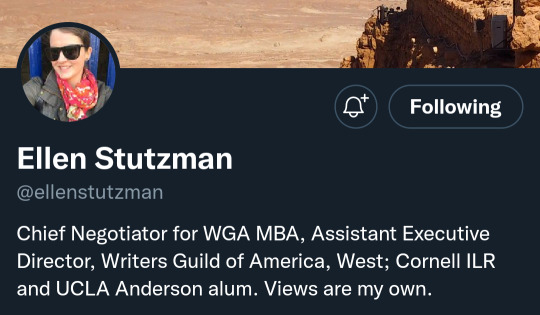
[Image ID: A tweet from John Rogers that he posted July 12th, 2023 that reads:
I was trying to be cool and professional about this strike, but this AMPTP “we want to drive them to homelessness” shit means I’m going to be dug in at WB Gate 4 like Hiroo Onada. They’re gonna have to send @ellenstutzman with a bullhorn to order me out of the bushes.
The second image is Ellen Stutzman's Twitter bio that says:
Cheif Negotiator for WGA MBA, Assistant Executive Director, Writers Guild of America, West; Cornell ILR and UCLA Anderson alum. Views are my own.
/End ID]
EDIT: Please see the update on this HERE
4K notes
·
View notes
Text
This post is made with speech to text because my hand hurts from typing so much today. Please forgive any typos or speech to text swapping similar sounding words.
If you would like to start writing your own image descriptions, feel free to ask any questions.
The main things to keep in mind is that they should begin with some variation of image description start or ID, and end with some variation of image description and, and ID or something like that. This distinguish the image description from the caption or anything else.
Image descriptions should not be written in italics, bold, all caps, or any colors. If text in the image is in all caps, write it in regular case, and simply note before or after it that it's in all caps.
Image descriptions should describe all images in the post, without skipping any. This includes images that are nothing but text.
Plain text image descriptions in the body of the post are more accessible than alt text alone, because many people who need image descriptions cannot use alt text, and Tumblr is known for its glitches, so the accessibility of the alt text all by itself varies widely over time.
It is more accessible to have the image descriptions indented than not, because this helps to visually separate the image description from the caption. Having brackets or parentheses at the end is also helpful for this. This allows people to easily distinguish between the caption and the image description if they need to.
If you are an artist, writing image descriptions for your art will give you full control over the image description, and will allow you to correctly identify details that others might miss. This gives you the opportunity to show which parts of your art hold meaning to you and are important to notice.
If you are describing real people who are unknown to you, unless it is specified within the post or you are already aware, please do not assign any gendered terms to them, or any " male presenting or female presenting" terms like that. This is completely unnecessary and leads to misgendering. It is best to simply describe visible facts about the people. Hair color, length, clothes and style, pose, expression, the light or darkness of their skin, things like that. Do not assume that someone is white simply because they have light skin.
Do not use image descriptions to lie to the audience in any way and do not use image descriptions to make jokes where the audience reading the image description is the butt of the joke.
As an example, if there is a very clearly fake screenshot, do not say that it is simply a screenshot, or if a photo is very blatantly photoshopped, do not say that it is simply a photo. Say an edited photo, a badly edited photo, a screenshot with editing, something like that to indicate the changes have been made and then what you are going to be describing is not the natural version.
As an example, you would say a crab photoshopped to be driving a car. Rather than a photo of a crab driving a car.
Unless you are transcribing a text within the image, do not use meme speak within image descriptions. Do not refer to dogs as doggos for example, unless it is to specify that the dog in the image is, within the image, labeled as a doggo. Do not describe someone walking downstairs as breasted bubbly downstairs, even if it is an actor humorously walking down the stairs to imitate that sentence. Describe the facts of the movements, and then you can make the comparison for clarity.
If someone adds an image description to your post whether this be an original post or a reblog that you have added an image to, it doesn't matter how many notes to post already has, please copy and paste that image description into the original post or your original reblog. If it is a new post that has only a few notes from friends, after you update the original, you can just ask your friends to delete the reblogs of the inaccessible version and reblog the new one. Most people who are good people and care about disabled people will happily do so.
Keep in mind that image descriptions are accessibility tools. Treat them as such.
Anyone can write image descriptions. You do not need any special qualifications or training. As long as you are willing to take constructive criticism if you make a mistake, an image description written by someone who's new to it and honestly doing their best with good intentions is better than no image description at all.
I'm sure I'm forgetting some things, so please feel free to add on more tips and advice.
#made with speech to text#image descriptions#accessability#disabled#cripplepunk#neuropunk#autistic#adhd#if you care about disabled people#start writing image descriptions#especially if you're able-bodied
1K notes
·
View notes
Text
I want to make my posts more accessible, but can't write IDs myself: a guide
[Plain text: "I want to make my posts more accessible, but can't write IDs myself: a guide." End plain text.]
While every image posted online should be accessible in an ideal world, we all know it 1) takes time to learn how to write image descriptions, and 2) is easy to run out of spoons with which to write IDs. And this says nothing of disabilities that make writing them more challenging, if not impossible — especially if you're a person who benefits from IDs yourself.
There are resources for learning how to write them (and if you already know the basics, I'd like to highlight this good advice for avoiding burnout) — but for anyone who cannot write IDs on their original posts at any current or future moment, for any reason, the there are two good options for posting on Tumblr.
1. Crowdsource IDs through the People's Accessibility Discord
[Plain text: "1. Crowdsource IDs through the People's Accessibility Discord". End plain text.]
The People's Accessibility Discord is a community that volunteers description-writing (and transcript-writing, translation, etc) for people who can't do so themselves, or feel overwhelmed trying to do so. Invite link here (please let me know if the link breaks!)
The way it works is simple: if you're planning to make an original post — posting art, for example — and don't know how to describe it, you can share the image there first with a request for a description, and someone will likely be able to volunteer one.
The clear upside here (other than being able to get multiple people's input, which is also nice) is that you can do this before making the Tumblr post. By having the description to include in your post from the start, you can guarantee that no inaccessible version of the post will be circulated.
You can also get opinions on whether a post needs to be tagged for flashing or eyestrain — just be able to spoiler tag the image or gif you're posting, if you think it might be a concern. (Also, refer here for info on how to word those tags.)
The server is very chill and focused on helping/answering questions, but if social anxiety is too much of a barrier to joining, or you can't use Discord for whatever reason, then you can instead do the following:
2. Ask for help on Tumblr, and update the post afterwards
[Plain text: "Ask for help on Tumblr, and update the post afterwards". End description.]
Myself and a lot of other people who describe posts on this site are extra happy to provide a description if OP asks for help with one! This does leave the post inaccessible at first, so to minimize the drawbacks, the best procedure for posting an image you can't fully describe would be as follows:
Create the tumblr post with the most bare-bones description you can manage, no matter how simple (something like "ID: fanart of X character from Y. End ID" or "ID: a watercolor painting. End ID," or literally whatever you can manage)
Use a tool like Google Lens or OCR to extract text if applicable and if you have the energy, even if the text isn't a full image description (ideally also double-check the transcriptions, because they're not always perfect)
Write in the body of the post that you'd appreciate a more detailed description in the notes!
Tag the post as "undescribed" and/or "no id" only if you feel your current, bare-bones description is missing out on a lot of important context
When you post it and someone provides an ID, edit the ID into the original post (don't use read mores, italics, or small text)
Remove the undescribed tag, if applicable. If you're posting original art, you can even replace it with a tag like "accessible art" for visibility!
And congrats! You now have a described post that more people will be able to appreciate, and you should certainly feel free to self-reblog to give a boost to the new version!
620 notes
·
View notes
Text
Philza replied to QSMP Updates on twitter!


[Image ID:
A cropped screenshot of a tweet by QSMP Updates @/QsmpEN with a reply by Ph1LzA @/Ph1LzA.
QSMP Updates’ tweet reads “🔔| QSMP Day 55, Eggstatistics!
Cause of death:
Tallulah: Slain by Philza.” Attached is a graphic of all the eggs with their lives an task counters. Also Gegg.
Phil’s reply reads “take me instead”. Attached is an edited meme image of a person laying on the floor at the bottom of a staircase next to a variety of items. The person has been edited to wear Kisuke Urahara’s clothes and a Minecraft head like Phil’s. The items are a variety of Minecraft items: a diamond sword, a gold bar and nugget, an iron bar and a compass.
End ID]
1K notes
·
View notes
Note
is there any possibility of keeping the legacy editor as an option? for content creators, the new editor completely ruins the quality of our gifs/edits/art and it's really frustrated to be forced into using an editor that's going to kill the quality of the creations that we spend time perfecting.
Answer: Hello, @junghaesin!
Thanks for writing in. And thank you to everyone else who has shared similar feedback.
So, tl;dr—this is actually a blog theme issue. Your theme is not showing images in posts created by the new editor as you expect.
GIFs uploaded via the legacy editor or the new editor are actually processed the same way. There is no difference in bit depth or in resolution. You can see this by looking at your posts inside the Tumblr dashboard instead (e.g. instead of yourblog.tumblr.com/post/id, go to tumblr.com/yourblog/id).
The reason why you see a quality difference is because posts created by the new editor are treated as text posts by older blog themes. Themes often add padding around all the content of a text post—including any images that appear in it. If your theme presents posts as 540px wide, then in a text post, with that additional padding, the available space for your images is actually less than 540px. As a result, the browser will scale your images down to fit, and when this happens, image quality takes a hit.
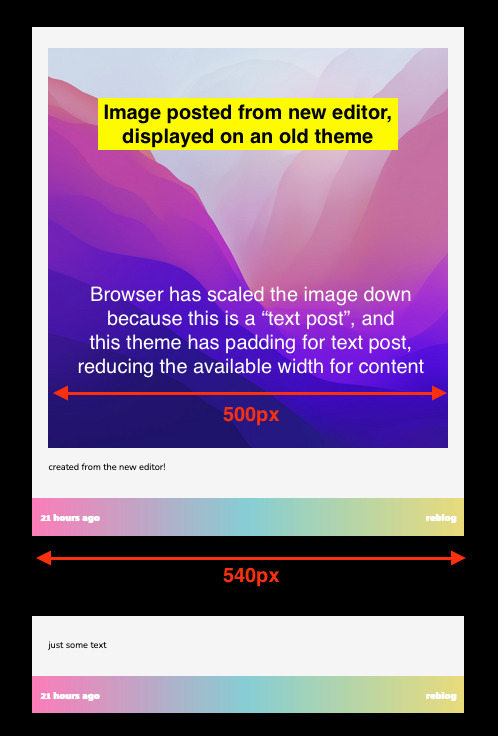

The solution—update to a more modern, up-to-date theme, like Vision or Stereo. Theme developer @eggdesign also built a theme template that works with new posts, that you can build on top of! These modern themes apply padding only to text blocks rather than the whole post, so image blocks receive no padding and are served at their full 540px width, just like the Dashboard. From what we’ve seen, this fixes all of the issues about perceived GIF quality on blogs.
We know. Changing your theme is a lot of work. In the near future, we’re looking into ways to make this transition easier—for example, helping you identify themes that work well with new posts in the Theme Garden. But working with new posts is the way forward—the new posts use a format that opens up a lot of opportunities in the future.
Why can’t you add post types to posts from the new editor? Why not serve new posts as photo posts instead of text posts?
The new editor uses a new post format, called Neue Post Format (NPF). NPF has given us a huge boost in flexibility when it comes to what content can be in posts—remember the time when you couldn’t even upload images to reblogs? Or how old chat and quote posts magically change authors? NPF helped us fix both of these things. It removed constraints—including post types, which limit each post to one specific type of content.
But existing blog themes still need to be able to display these posts. Because NPF posts can include media anywhere (while most of the old post types have a rigid structure for media), it was safest for us to categorize NPF posts as the least constrained post type—text posts. It’s the best we can do to make these posts backward-compatible with existing blog themes.
In lieu of post types, we’ve added an {NPF} theme variable per post that custom themes can leverage. Theme developers must update their themes to take advantage of this new data to retain full control of the HTML output of posts.
You can read more about these decisions, and the Neue Post Format specification, here and here.
Thanks for your feedback, and keep it coming!
With love,
—The Tumblr WIP Team
1K notes
·
View notes
Text



Fucking hell
[Image ID: The first image is of the Destiel confession meme edited so that Dean answers 'there's gonna be a dashcon 2' to Cas' 'I love you'. The second is of a web page with the words 'Coming soon to Toronto' with a button to subscribe for updates and a countdown reading 345 days, 7 hours, 6 minutes, and 44 seconds. It has a description saying 'Please check in soon or subscribe to our mailing list for updates about DashCon 2025!' The third has text from a Frequently Asked Questions page where the question is 'Will there be a ball pit' and the answer is 'Yes.' /End ID]
#destiel#destiel confession meme#destiel meme#destiel news#destiel news meme#dashcon#dashcon 2#destiel news channel
125 notes
·
View notes
Text
Writeblr intro post
So yeah when I first came here I didn't know this was a thing so I've been working on this in the background. Now that it won the poll, I'm making it now!
I'm going to edit this post as I go so it has more links as I make posts about my WIPs!
About Me
Hi. Call me Kaylin. It's a pen name but I like it. (Some people are just finding out this isn't my real name and y'all should've read the bio)
I'm an education major and do writing on the side and it's a huge passion of mine (hence why I want to teach literacy)
Asexual demiromantic sapphic (she/her) currently in a relationship - (I am comfortable within reason to talk about my experiences)
Love ask games and tag games and generally interacting with others
Love reblogging mutuals' writing talking about WIPs!
21+ but my WIPs are YA - I don't usually reblog anything with a mature community label (sorry in advance for mutuals who do), but when I do I mark it 18+ and I try to label content warnings (LET ME KNOW IF I MISSED SOMETHING)
I'm an educator by heart so I love giving feedback, know a lot about kids, and of course education psychology and theory
I have minor scoliosis, early start of arthritis in my hands, and chronic headaches and migraines attacks in control with medication if anyone needs to ask me about these experiences for writing purposes. I also occasionally use a cane due to knee pain from an injury.
I have an ultimate get to know me game if you want to check that out
My asks are always open! Feel free to stop in whenever you want!
My WIPs
The Secret Portal
See linked intro post for more detail!
YA sci-fi/fantasy
Planned to be a five book series
Quick version: A bunch of adolescents discover a portal to a dimension populated by people with powers. There's also a war. Yayyy.
The first installment is currently in the process of being read by beta readers. Apply to be one here!
One to five game
Q&A (open at any time!)
Tagged as #the secret portal, #tsp, or #teaspoon if you want to give it a nickname. #tsp updates and #tsp excerpt are used as well. All characters get their own tag and #alium will be used when talking about my world building
Ask to be added to or removed from the tag list! @thepeculiarbird @illarian-rambling @televisionjester @finchwrites
@nebula--nix @literarynecromancy @honeybewrites @the-golden-comet
School of the Legends
See linked intro post for more detail!
YA urban fantasy fairy tale retelling
International school for people with gifts (born with), majicks (learn), and curses (given).
Currently in planning stage but five chapters have been written.
One to five game
Tagged as #school of the legends and #sotl. Also use #sotl updates and #sotl excerpt, though not as often as TSP
Ask to be added to or removed from the tag list! @illarian-rambling @katwritesshit @wyked-ao3
I have a WIP questionnaire I have gone for BOTH TSP and SOTL!
Other Ideas
It Was All Just a Dream - (linked WIP questionnaire) high school senior gets an entire redemption arc via vivid dream
The Emerald of Secrets - temporary title for vague fairy fantasy idea
Perspectives - we watch the same event five times in a row from different perspectives
Eternity - temporary title for a supernatural detective story
The Others - temporary title for a sci-fi apocalypse story
There are more but these are the main ones
What I Post or Reblog
Updates on my writing
Tag games and ask games! I love them dearly but it may take a bit to reply! I have a lot piled up and not all of them are simple. But I will get to them!!
Writing from others
Writing advice
Beta requests, book announcements, and intro posts to help boost!
I try to keep things positive! If I see a negative post about writing I'll usually reblog it with some positive spin. Sorry if that's annoying but it makes me sad that people aren't happy about writing.
I always try to include image IDs to make my blog accessible - if something is incorrect or you have any suggestions for making IDs better let me know!
#writers on tumblr#writing community#writeblr intro#writers of tumblr#writing on tumblr#writeblr community#writeblr#the secret portal#school of the legends#my intro post#my introduction#tsp#teaspoon#sotl#taglist
101 notes
·
View notes
Text

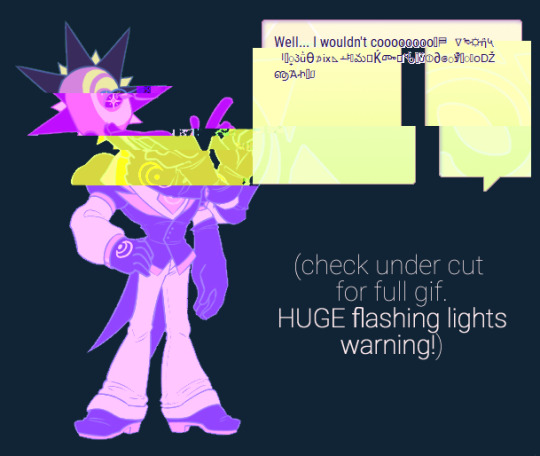
aldebaran isn't exactly stable.
while i have a very specific vision for the effect, i don't want to destroy the users' eyes. so there will be a way to select whether you want the simpler glitch effects or the full ones. the simpler ones are safer, if possibly unnerving. full ones use actual corrupted and edited images on top of the simpler effect, which is also faster.
i'll probably tweak it more and add a frame or two but i am also currently sick so i'm forced to slow down by the brain itself... maybe some other time.
oh yeah the balloon color scheme finally matches him, with some other tweaks on top as you can see. i may update aster's balloon again too.
[ID in ALT text. Flashing light gifs under cut!]


#original#artists on tumblr#oc#original character#ai oc#robot oc#webcore#aster#aldebaran (aster)#CaelOS#flashing lights#flashing gif#eyestrain#someone asked me about this before so: no this isn't painful for him; he's just spacing out no worries#Aster Terror Star devlog
192 notes
·
View notes
Text
Disability in Non-Fiction #1: Plain Text Edition
A plain text version of this post. Here you will find detailed image descriptions and easier-to-read versions of each book summary. If you think that any image descriptions/summaries need to be updated, please let me know!
================================================
‘How to Live Free in a Dangerous World’- Lawson, Shayla

[ID: A book cover. The background is a pale orange colour. In the centre, a large photograph of a person with brown skin standing in front a desert under a blue sky. They have short braided brown hair swept over their left eye, and have their arms crossed over their chest, with one hand resting on the side of their face. The title “How to Live Free in a Dangerous World” is around them in large orange writing that covers the length of the photo. The subtitle “A Decolonial Memoir” is to the right their head in very small white writing. The author’s name “Shayla Lawson” is below the title, at the bottom of the photograph, in smaller yellow writing. Black text at the bottom of the cover reads, under the author’s name, reads “author of ‘this is major’, a national book critics circle award finalist”. /end]
Summary:
Poet and journalist Shayla Lawson follows their National Book Critics Circle finalist This Is Major with these daring and exquisitely crafted essays, where Lawson journeys across the globe, finds beauty in tumultuous times, and powerfully disrupts the constraints of race, gender, and disability.
With their signature prose, at turns bold, muscular, and luminous, Shayla Lawson travels the world to explore deeper meanings held within love, time, and the self.
Through encounters with a gorgeous gondolier in Venice, an ex-husband in the Netherlands, and a lost love on New Year’s Eve in Mexico City, Lawson’s travels bring unexpected wisdom about life in and out of love. They learn the strength of friendships and the dangers of beauty during a narrow escape in Egypt. They examine Blackness in post-dictatorship Zimbabwe, then take us on a secretive tour of Black freedom movements in Portugal.
Through a deeply insightful journey, Lawson leads readers from a castle in France to a hula hoop competition in Jamaica to a traditional theater in Tokyo to a Prince concert in Minnesota and, finally, to finding liberation on a beach in Bermuda, exploring each location—and their deepest emotions—to the fullest. In the end, they discover how the trials of marriage, grief, and missed connections can lead to self-transformation and unimagined new freedoms.
‘Being Seen’- Sjunneson, Elsa

[ID: A book cover. It is a dark black with faint, grey, writing over it. The writing, from top to bottom, reads:
“Elsa Sjunneson”
“Being Seen”
“One Deafblind Woman’s Fight to End Ableism”
All in capitals. The “I” in “Being Seen” is designed to look like an opening of sorts, with a ray of light coming through. /end]
Summary:
A deafblind writer and professor explores how the misrepresentation of disability in books, movies, and TV harms both the disabled community and everyone else.
As a deafblind woman with partial vision in one eye and bilateral hearing aids, Elsa Sjunneson lives at the crossroads of blindness and sight, hearing and deafness—much to the confusion of the world around her. While she cannot see well enough to operate without a guide dog or cane, she can see enough to know when someone is reacting to the visible signs of her blindness and can hear when they’re whispering behind her back. And she certainly knows how wrong our one-size-fits-all definitions of disability can be.
As a media studies professor, she’s also seen the full range of blind and deaf portrayals on film, and here she deconstructs their impact, following common tropes through horror, romance, and everything in between. Part memoir, part cultural criticism, part history of the deafblind experience, Being Seen explores how our cultural concept of disability is more myth than fact, and the damage it does to us all.
‘Disability Pride’- Mattlin, Ben

[ID: A book cover. The background is made of simple, colourful red, cream, white, yellow and teal shapes. Large text reads, from top to bottom:
“Disability Pride” in large, black capitals,
“Dispatches from a Post-ADA World”in smaller, black capitals,
“Ben Mattlin”, in slightly bigger red capitals. /end]
Summary:
An eye-opening portrait of the diverse disability community as it is today and how attitudes, activism, and representation have evolved since the passage of the Americans with Disabilities Act (ADA).
In Disability Pride, disabled journalist Ben Mattlin weaves together interviews and reportage to introduce a cavalcade of individuals, ideas, and events in engaging, fast-paced prose. He traces the generation that came of age after the ADA reshaped America, and how it is influencing the future. He documents how autistic self-advocacy and the neurodiversity movement upended views of those whose brains work differently. He lifts the veil on a thriving disability culture—from social media to high fashion, Hollywood to Broadway—showing how the politics of beauty for those with marginalized body types and facial features is sparking widespread change.
He also explores the movement’s shortcomings, particularly the erasure of nonwhite and LGBTQIA+ people that helped give rise to Disability Justice. He delves into systemic ableism in health care, the right-to-die movement, institutionalization, and the scourge of subminimum-wage labor that some call legalized slavery. And he finds glimmers of hope in how disabled people never give up their fight for parity and fair play.
Beautifully written, without anger or pity, Disability Pride is a revealing account of an often misunderstood movement and identity, an inclusive reexamination of society’s treatment of those it deems different.
‘Crip Kinship’- Kafai, Shayda

[ID: A book cover. The background is light blue, with colourful pictures of butterflies, flowers and a house setting featured in the centre. Lower right centre of the image, a black figure in a long sleeved, billowing dress, holding a curved black walking stick in their right hand. Behind them, a drawing of a room with a table, chair, pink wall with a window, and a blank wall with an orange picture. Text on the book cover, from top to bottom, reads:
The title “Crip Kinship” in large black font at the top of the image,
The subtitle “The Disability Justice & Art Activism of Sins Invalid” in smaller black capitals, in the upper right corner of the image,
The authors name “Shayda Kafai” in medium black capitals in the lower right of the image, partially overlapping the figure in the dress. /end]
Summary:
The remarkable story of Sins Invalid, a performance project that centres queer disability justice.
In recent years, disability activism has come into its own as a vital and necessary means to acknowledge the power and resilience of the disabled community, and to call out ableist culture wherever it appears.
Crip Kinship explores the art activism of Sins Invalid, a San Francisco Bay Area-based performance project, and its radical imaginings of what disabled, queer, trans, and gender-nonconforming bodyminds of colour can do: how they can rewrite oppression, and how they can gift us with transformational lessons for our collective survival.
Grounded in the disability justice framework, Crip Kinship investigates the revolutionary survival teachings that disabled, queer of colour community offers to all our bodyminds. From their focus on crip beauty and sexuality to manifesting digital kinship networks and crip-centric liberated zones, Sins Invalid empowers and moves us toward generating our collective liberation from our bodyminds outward.
‘Sounds Like Home’- Wright, Mary Herring

[ID: A book cover. The background is yellow. A black and white photograph in the centre shows two young black children and a dog in front of a car. The title “Sounds Like Home” is at the tope in large, curvy black writing. The subtitle “Growing Up Black and Deaf in the South” is written in small orange writing, on three black bars on the right side of the cover. The author’s name “Mary Herring Wright” is written in curvy black writing, slightly smaller than the title, at the bottom of the cover. /end]
Summary:
Mary Herring Wright’s memoir adds an important dimension to the current literature in that it is a story by and about an African American deaf child. The author recounts her experiences growing up as a deaf person in Iron Mine, North Carolina, from the 1920s through the 1940s. Her story is unique and historically significant because it provides valuable descriptive information about the faculty and staff of the North Carolina school for Black deaf and blind students from the perspective of a student as well as a student teacher. In addition, this engrossing narrative contains details about the curriculum, which included a week-long Black History celebration where students learned about important Blacks such as Madame Walker, Paul Laurence Dunbar, and George Washington Carver. It also describes the physical facilities as well as the changes in those facilities over the years. In addition, Sounds Like Home occurs over a period of time that covers two major events in American history, the Depression and World War II.
Wright’s account is one of enduring faith, perseverance, and optimism. Her keen observations will serve as a source of inspiration for others who are challenged in their own ways by life’s obstacles.
‘The Right to Maim’- Puar, Jasbir K.

[ID: A book cover. The background is white. A painting stretches from the bottom of the cover to bottom of top quarter. In the upper quarter of the cover, text reads:
The author’s name “Jasbir K. Puar” is at the top in black writing.
The title “The Right to Maim” is immediately below this in red caps.
The subtitle “Debility, Capacity, Disability” is immediately below this in smaller, yellow caps.
The painting is immediately below this. The background is a dark cream. It appears to show a humanoid figure climbing a mound. Two other figures appear to be falling off the mound. There are splashes of red paint around the mound and the figure on it. /end]
Summary:
In The Right to Maim Jasbir K. Puar brings her pathbreaking work on the liberal state, sexuality, and biopolitics to bear on our understanding of disability. Drawing on a stunning array of theoretical and methodological frameworks, Puar uses the concept of “debility”—bodily injury and social exclusion brought on by economic and political factors—to disrupt the category of disability. She shows how debility, disability, and capacity together constitute an assemblage that states use to control populations. Puar’s analysis culminates in an interrogation of Israel’s policies toward Palestine, in which she outlines how Israel brings Palestinians into biopolitical being by designating them available for injury. Supplementing its right to kill with what Puar calls the right to maim, the Israeli state relies on liberal frameworks of disability to obscure and enable the mass debilitation of Palestinian bodies. Tracing disability’s interaction with debility and capacity, Puar offers a brilliant rethinking of Foucauldian biopolitics while showing how disability functions at the intersection of imperialism and racialized capital.
‘Uncomfortable Labels’- Dale, Laura Kate

[ID: A book cover. The background is a close photograph of some kind of knitted garment, and its label. The garment is blue. The label is in the centre. Text on the label reads:
The title “Uncomfortable Labels” in large black caps
The subtitle “My Life as a Gay Autistic Trans Woman” in smaller black caps, lower left of this
The author’s name “Laura Kate Dale” at the bottom of the label in black writing.
A smaller label attached to the bottom has a single, black capitalised “M” written on it. /end]
Summary:
“So while the assumption when I was born was that I was or would grow up to be a neurotypical heterosexual boy, that whole idea didn’t really pan out long term.”
In this candid, first-of-its-kind memoir, Laura Kate Dale recounts what life is like growing up as a gay trans woman on the autism spectrum. From struggling with sensory processing, managing socially demanding situations and learning social cues and feminine presentation, through to coming out as trans during an autistic meltdown, Laura draws on her personal experiences from life prior to transition and diagnosis, and moving on to the years of self-discovery, to give a unique insight into the nuances of sexuality, gender and autism, and how they intersect.
Charting the ups and downs of being autistic and on the LGBT spectrum with searing honesty and humour, this is an empowering, life-affirming read for anyone who’s felt they don’t fit in.
'Brilliant Imperfections'- Clare, Eli

[ID: A book cover. A photograph of stones can be seen. Over it, a dark box stretching from left to right at the top of the image. Text in the box reads:
“Brilliant Imperfection”, in large caps. “Brilliant” is in green, “Imperfection is in white.
“Grappling With Cure”, in small, green caps.
“Eli Clare”, in white caps. /end]
Summary:
In Brilliant Imperfection Eli Clare uses memoir, history, and critical analysis to explore cure—the deeply held belief that body-minds considered broken need to be fixed.
Cure serves many purposes. It saves lives, manipulates lives, and prioritizes some lives over others. It provides comfort, makes profits, justifies violence, and promises resolution to body-mind loss. Clare grapples with this knot of contradictions, maintaining that neither an anti-cure politics nor a pro-cure worldview can account for the messy, complex relationships we have with our body-minds.
The stories he tells range widely, stretching from disability stereotypes to weight loss surgery, gender transition to skin lightening creams. At each turn, Clare weaves race, disability, sexuality, class, and gender together, insisting on the nonnegotiable value of body-mind difference. Into this mix, he adds environmental politics, thinking about ecosystem loss and restoration as a way of delving more deeply into cure.
Ultimately Brilliant Imperfection reveals cure to be an ideology grounded in the twin notions of normal and natural, slippery and powerful, necessary and damaging all at the same time.
================================================
A short list of 8 non-fiction books featuring and/or discussing disability!
I don't highlight the non-fiction section of the archive enough, so I think this is a perfect opportunity.
A plain text version of this post exists here, featuring more detailed image descriptions of each book cover and easier-to-read versions of every summary.
Books on this list:
‘How to Live Free in a Dangerous World’- Lawson, Shayla
‘Being Seen’- Sjunneson, Elsa
‘Disability Pride’- Mattlin, Ben
‘Crip Kinship’- Kafai, Shayda
‘Sounds Like Home’- Wright, Mary Herring
‘The Right to Maim’- Puar, Jasbir K.
‘Uncomfortable Labels’- Dale, Laura Kate
'Brilliant Imperfections'- Clare, Eli
All of these books and more can be found on the Disability Book Archive.
Happy Disability Pride Month!
#books#disability books#disability#disability representation#the disability book archive#lgbtq books#lgbtq+#lgbtq representation#non fiction#disability pride month#disability pride#disability history#link#images#described#alt text#plain text#disability in non fiction#part 1
87 notes
·
View notes
Text
Abolition For Beginners (2023 Edition)
In honor of Tyre Nichols and all others we have lost to policing and imprisonment. In honor of Black History Month. In honor of Better Future Program's mission to educate and serve marginalized youth globally... Let's break down abolition, again. (As usual on Tumblr, tap for better quality.)
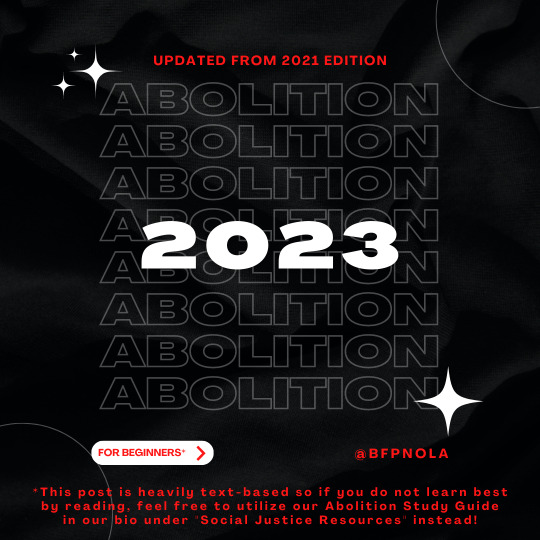
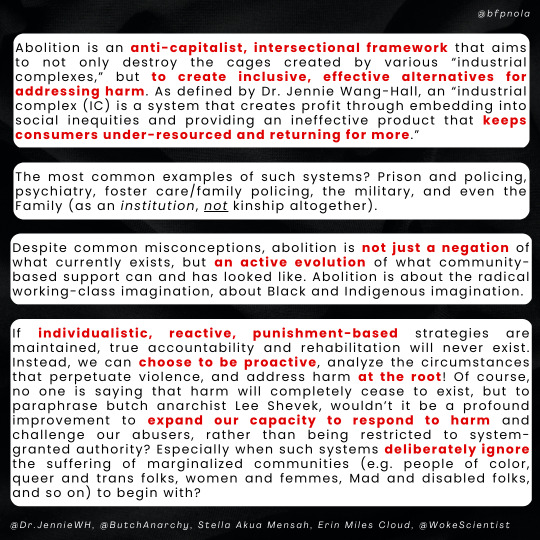

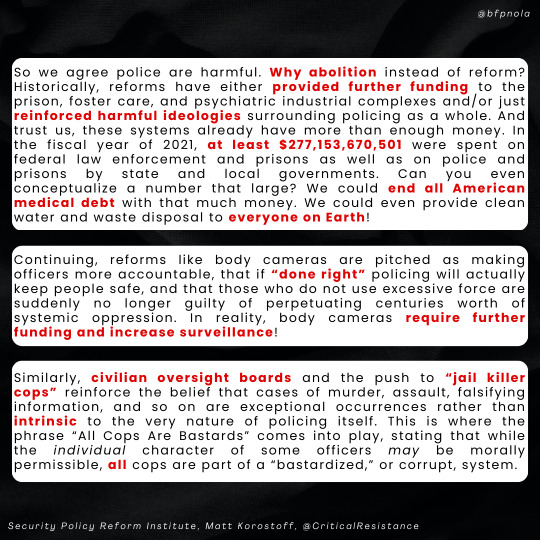
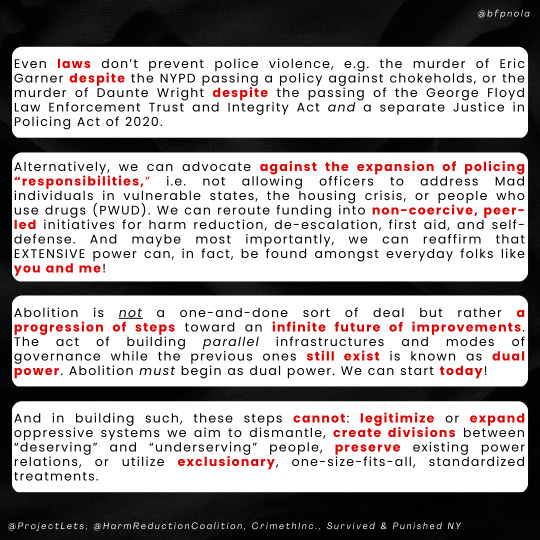


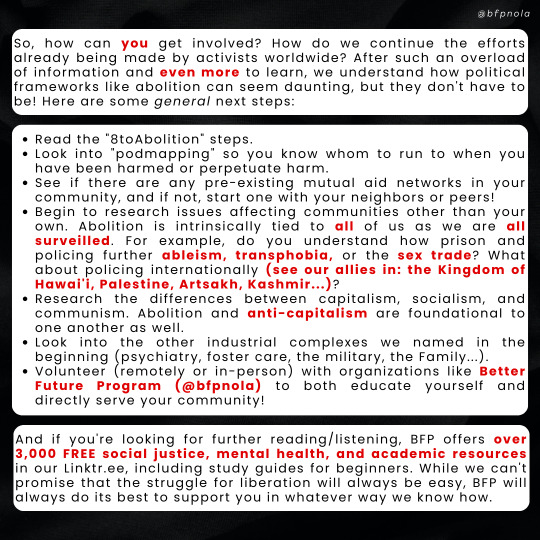
Better Future Program's Linktr.ee | Donate | Liberation Library | Open Leadership Positions | Staff Application | Discord Server
Image description below. Written by @reaux07. Proofread by the volunteers and supporters of @bfpnola.
Image Description:
[ID: All of the following slides use a wrinkled, black fabric as their background with black text (bolded red added for emphasis) on top of white boxes with rounded corners. “@bfpnola” is written in the top right corner and the sources for the slide are in the bottom left corner.
Title Slide (No. 1):
Written in red text, “UPDATED FROM 2021 EDITION.” The outlines of the word “ABOLITION” is written line by line 8 times in light grey with the year “2023” written on top in bold, white lettering. Below, written in red within a white bubble and red arrow, it reads “FOR BEGINNERS*.” Across from the bubble, “@BFPNOLA” is in red. Below, in red again, the asterisk mentioned before leads to the following note: “This post is heavily text-based so if you do not learn best by reading, feel free to utilize our Abolition Study Guide in our bio under "Social Justice Resources" instead!” Lastly, white stars and outlines of grey circles can be seen in each corner of the slide.
Slide No. 2 reads:
Abolition is an anti-capitalist, intersectional framework that aims to not only destroy the cages created by various “industrial complexes,” but to create inclusive, effective alternatives for addressing harm. As defined by Dr. Jennie Wang-Hall, an “industrial complex (IC) is a system that creates profit through embedding into social inequities and providing an ineffective product that keeps consumers under-resourced and returning for more.”
The most common examples of such systems? Prison and policing, psychiatry, foster care/family policing, the military, and even the Family (as an institution, not kinship altogether).
Despite common misconceptions, abolition is not just a negation of what currently exists, but an active evolution of what community-based support can and has looked like. Abolition is about the radical working-class imagination, about Black and Indigenous imagination.
If individualistic, reactive, punishment-based strategies are maintained, true accountability and rehabilitation will never exist. Instead, we can choose to be proactive, analyze the circumstances that perpetuate violence, and address harm at the root! Of course, no one is saying that harm will completely cease to exist, but to paraphrase butch anarchist Lee Shevek, wouldn’t it be a profound improvement to expand our capacity to respond to harm and challenge our abusers, rather than being restricted to system-granted authority? Especially when such systems deliberately ignore the suffering of marginalized communities (e.g. people of color, queer and trans folks, women and femmes, Mad and disabled folks, and so on) to begin with?
Sources: @Dr.JennieWH, @ButchAnarchy, Stella Akua Mensah, Erin Miles Cloud, @WokeScientist
Slide No. 3 reads:
Before we continue any further, let’s destroy the myth that cops actually stop violence. First off, we can’t depend on crime stats at face value because this begs the question of who exactly gets to define what counts as a “crime” and why (e.g. drug possession and sleeping in public vs. tax evasion of the wealthy and wage theft). Continuing, crime rates often only reflect violations that have actually been reported, chosen to be shown, and deemed out of line. By this logic, crime rates are simply reflections of cops’ perceptions, not of the material and emotional realities of the proletariat (i.e. the working-class).
As for perpetuating violence, “US law enforcement killed at least 1,183 people in 2022, making it the deadliest year on record for police violence.” (And those are just the deaths that were reported. In our home state of Louisiana, turns out the Jefferson Parish Sheriff’s Office, as of January 12, 2023, has been unlawfully destroying records of officer misconduct for at least 10 years.) Many (69%) of these murders were cases in which no offense was alleged, were mental health or welfare checks, or involved traffic violations and other nonviolent offenses.
This is, of course, without even touching on the involuntary servitude (i.e. enslavement) and maltreatment ongoing in American prisons. How many more deaths must occur before the general public says enough is enough? Or is this acceptable since these are working-class, disabled, Mad, non-white, queer, and trans lives being lost?
Sources: @InterruptCrim, The Guardian, Mapping Police Violence, @VeriteNewsNola
Slide No. 4 reads:
So we agree police are harmful. Why abolition instead of reform? Historically, reforms have either provided further funding to the prison, foster care, and psychiatric industrial complexes and/or just reinforced harmful ideologies surrounding policing as a whole. And trust us, these systems already have more than enough money. In the fiscal year of 2021, at least $277,153,670,501 were spent on federal law enforcement and prisons as well as on police and prisons by state and local governments. Can you even conceptualize a number that large? We could end all American medical debt with that much money. We could even provide clean water and waste disposal to everyone on Earth!
Continuing, reforms like body cameras are pitched as making officers more accountable, that if “done right” policing will actually keep people safe, and that those who do not use excessive force are suddenly no longer guilty of perpetuating centuries worth of systemic oppression. In reality, body cameras require further funding and increase surveillance!
Similarly, civilian oversight boards and the push to “jail killer cops” reinforce the belief that cases of murder, assault, falsifying information, and so on are exceptional occurrences rather than intrinsic to the very nature of policing itself. This is where the phrase “All Cops Are Bastards” comes into play, stating that while the individual character of some officers may be morally permissible, all cops are part of a “bastardized,” or corrupt, system.
Sources: Security Policy Reform Institute, Matt Korostoff, @CriticalResistance
Slide No. 5 reads:
Even laws don’t prevent police violence, e.g. the murder of Eric Garner despite the NYPD passing a policy against chokeholds, or the murder of Daunte Wright despite the passing of the George Floyd Law Enforcement Trust and Integrity Act and a separate Justice in Policing Act of 2020.
Alternatively, we can advocate against the expansion of policing “responsibilities,” i.e. not allowing officers to address Mad individuals in vulnerable states, the housing crisis, or people who use drugs (PWUD). We can reroute funding into non-coercive, peer-led initiatives for harm reduction, de-escalation, first aid, and self-defense. And maybe most importantly, we can reaffirm that EXTENSIVE power can, in fact, be found amongst everyday folks like you and me!
Abolition is not a one-and-done sort of deal but rather a progression of steps toward an infinite future of improvements. The act of building parallel infrastructures and modes of governance while the previous ones still exist is known as dual power. Abolition must begin as dual power. We can start today!
And in building such, these steps cannot: legitimize or expand oppressive systems we aim to dismantle, create divisions between “deserving” and “underserving” people, preserve existing power relations, or utilize exclusionary, one-size-fits-all, standardized treatments.
Sources: @ProjectLets, @HarmReductionCoalition, CrimethInc., Survived & Punished NY
Slide No. 6 reads:
One of the main questions brought up, though, is what abolitionists plan to do in the case of homicide, rape, domestic violence, and other harms. While this is entirely valid, this question seems to imply that 1) police are already effectively responding to such harms rather than perpetuating and/or ignoring them and 2) that there is one collective abolitionist response.
For one, the majority of sexual assault, for example, goes unreported and less than 0.5% of perpetrators are incarcerated. (And this assumes that through the reporting process and incarceration, survivors will somehow find healing, perpetrators will find understanding, and that sexual assault does not continue within prisons.) Meanwhile, let’s use our hometown as one example of many, a complaint of sexual violence is filed against a New Orleans Police Department officer every 10 days and nearly 1 in 5 NOPD officers have been reported for sexual and/or intimate partner violence.
And secondly, we have a plethora of organizations like Critical Resistance and cultures like that of the Diné (Navajo) to learn from and build upon. We don’t have to be stuck within this false dilemma fallacy, that there is only policing or total chaos. Don’t you see that that is the state’s way of constricting communal power?
Sources: @RAINN, @CopWatchNola, @WokeScientist
Slide No. 7 reads:
To expand this conversation, abolition heavily aligns with the political ideal of “anarchism.” Anarchism supports the absence of government and absolute freedom of the individual. And despite its negative connotations, anarchy also reflects an evolution of community-based care rather than just a deconstruction of what currently exists.
A simplified version of its 6 agreed-upon principles are:
Autonomy and Horizontality: define yourself on your own terms, we stand on an equal footing
Mutual Aid: bonds of solidarity form a stronger social glue than fear, support your community
Voluntary Association: associate or don't associate with whomever you wish
Direct Action: accomplish goals directly rather than depending on representatives or authorities
Revolution: overthrow those in power who enforce coercive hierarchies (ex. white supremacy)
Self-Liberation: you must be at the forefront of your own liberation, freedom must be taken
While being an abolitionist does not require alignment with anarchism, it is worth considering how the state plays such an enduring role in various social harms. Concurrently, whenever you treat other living beings with consideration and respect, come to reasonable compromise rather than coercion, and decide to share or delegate tasks, you are already living by anarchist principles.
Sources: Peter Gelderloos, David Graeber
Slide No. 8 reads:
So, how can you get involved? How do we continue the efforts already being made by activists worldwide? After such an overload of information and even more to learn, we understand how political frameworks like abolition can seem daunting, but they don't have to be! Here are some general next steps:
Read the "8toAbolition" steps.
Look into "podmapping" so you know whom to run to when you have been harmed or perpetuate harm.
See if there are any pre-existing mutual aid networks in your community, and if not, start one with your neighbors or peers!
Begin to research issues affecting communities other than your own. Abolition is intrinsically tied to all of us as we are all surveilled. For example, do you understand how prison and policing further ableism, transphobia, or the sex trade? What about policing internationally (see our allies in: the Kingdom of Hawai'i, Palestine, Artsakh, Kashmir...)?
Research the differences between capitalism, socialism, and communism. Abolition and anti-capitalism are foundational to one another as well.
Look into the other industrial complexes we named in the beginning (psychiatry, foster care, the military, the Family...).
Volunteer (remotely or in-person) with organizations like Better Future Program (@bfpnola) to both educate yourself and directly serve your community!
And if you're looking for further reading/listening, BFP offers over 3,000 FREE social justice, mental health, and academic resources in our Linktr.ee, including study guides for beginners. While we can't promise that the struggle for liberation will always be easy, BFP will always do its best to support you in whatever way we know how.
End ID.]
#reaux speaks#signal boost#tyre nichols#keenan anderson#cop city#abolition#abolish the police#defund the police#anti capitalism#intersectional feminism#palestine#black lives matter#blm#bipoc#disability justice#queer#trans#mass incarceration#study guide#mad liberation#psychiatry#family#military industrial complex#foster care#ACAB#tw rape mention#indigenous#anarchism#pinned post#BLACK HISTORY MONTH
730 notes
·
View notes